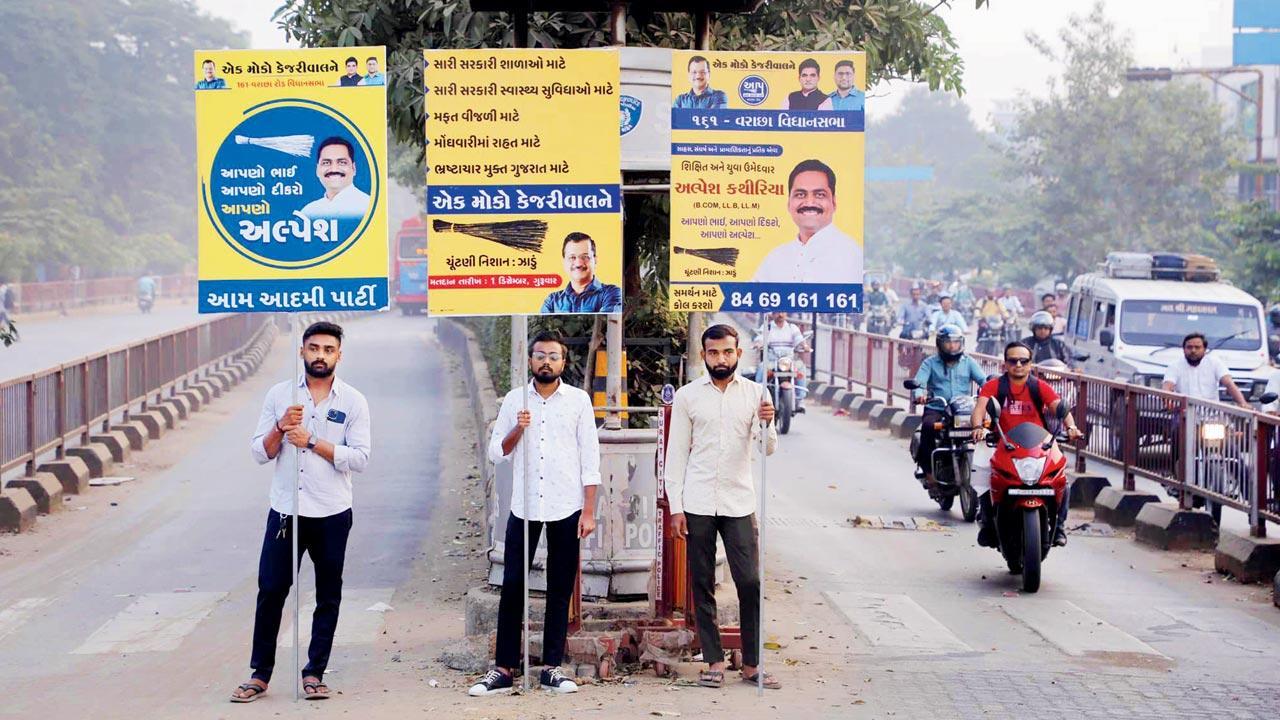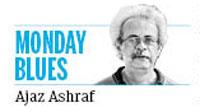A weak Congress left a hole in the state with no strong Opposition, and Kejriwal’s party filled that void. In addition, the party’s Delhi model of governance has wowed young voters and intellectuals alike

AAP workers campaign on a road in Gujarat, increasing the party’s visibility and reaching out to more voters. Pic/Twitter
 The Gujarat Assembly elections survey by Lokniti-Centre for the Study of Developing Societies (Lokniti-CSDS) has sent a frisson among political observers. The survey shows the Aam Aadmi Party could poll 22 per cent of votes, the Congress 21 per cent and the Bharatiya Janata Party a whopping 47 per cent. These findings assure a comfortable victory for the BJP, a scenario surprising to few.
The Gujarat Assembly elections survey by Lokniti-Centre for the Study of Developing Societies (Lokniti-CSDS) has sent a frisson among political observers. The survey shows the Aam Aadmi Party could poll 22 per cent of votes, the Congress 21 per cent and the Bharatiya Janata Party a whopping 47 per cent. These findings assure a comfortable victory for the BJP, a scenario surprising to few.
What is the excitement about, you may ask. Well, in 2017, the AAP contested 29 Assembly seats and polled 0.10 per cent of votes. This means the party has gained 22 per cent of votes over the last five years, an astonishing feat. The Lokniti-CSDS survey has sparked murmurs accusing AAP leader Arvind Kejriwal of playing the BJP’s game to split the Opposition votes—and relegating the Congress to the third spot.
In my quest to fathom the AAP’s rise, I turned to Mahashweta Jani, who, as the Gujarat State Coordinator for Lokniti-CSDS for the last 12 years, is responsible for collecting data from the field. Combining data with her personal observations, Mahashweta says, “The AAP has stepped into the vacuum in Gujarat’s Opposition space.”
The 2017 elections were fought fiercely, with the Congress winning 77 seats against the BJP’s 99. Yet the Congress squandered its gains—as many as 20 of the sitting MLAs joined the BJP, as did its young stars of 2017, such as Alpesh Thakor and Hardik Patel. The exodus from the Congress continues unabated.
“People feel voting for the Congress does not lead to a strong opposition against the BJP,” Mahashweta says. The Congress has not visibly engaged in the politics of streets, in sharp contrast to the AAP turning the spotlight on examination papers getting leaked last year. Its state president, Gopal Italia, is combative, acquiring the rebel tag by hurling, in 2017, a shoe at Gujarat’s home minister on a corruption issue.
Mahashweta says, “Kejriwal has created visibility for his party. At a traffic signal, if you see three-wheelers with Modi’s photos, you also see those with Kejriwal’s. I have never seen this happen with Rahul Gandhi.” Worse, the death of Ahmed Patel has deprived the Congress of a leader who had the skills to liaison with corporation members, MLAs, MPs and ordinary workers to stitch together a network that gave visibility to the Congress campaign.
But now, Rahul is too busy with the Bharat Jodo Yatra to spare time for Gujarat, which seems not to matter to the Congress. Tired of waiting for a Congress revival in the state and enthused by the AAP’s energy, non-BJP voters in Gujarat have pinned their hope on Kejriwal. This has not been an overnight development, for the AAP polled 13.28 per cent of votes in the elections to eight municipal corporations last year.
Mahashweta disses those analysts who say the AAP’s rise is predicated on offering freebies and hijacking the subaltern base of the Congress. “The support for AAP is strongest in the 18-25 age group. Otherwise, there is a minor variation in its votes across classes and castes,” Mahashweta says, adding that Kejriwal’s model of governance in Delhi, signified by quality public education, healthcare and subsidised electricity, is a compelling factor behind his party’s growing attraction for Gujaratis.
“Even intellectuals are moving towards AAP,” Mahashweta says. This is just the group which should have recoiled from the AAP’s silence on the interminable othering of Muslims. Based on her own experiences of living in Gujarat, she says the Hindutva domination of Gujarat for 25 years has altered the people’s mindset, palpable from this story of a lower-class self-employed person. He and his friends decided to have the AAP symbol as their WhatsApp display photo. The other day, BJP supporters came to them and said, “When miyas [Muslims] will not let you do your business, you will realise your mistake.” Others told me that many vote for the BJP as they believe Prime Minister Narendra Modi can “fix miyas” and protect Gujarat from neighbouring Pakistan.
Kejriwal’s silence is his strategic necessity, argues Mahashweta, who is disapproving of his rightwing lurch and tendency to personalise, like Modi, electoral politics and policies. “But let us have no illusion—if Kejriwal were to speak for Muslims, OBC and upper caste voters would desert him,” she says.
That Kejriwal’s politics is strategic rather than ideological is evident from the AAP’s decision to choose Isudan Gadhvi as its chief ministerial candidate. A shriekier version of Arnab Goswami, Gadhvi became extremely popular for raising social issues on his show, Mahamanthan, on the Gujarati channel VTV. Clips of his shows were widely shared in rural Gujarat, particularly in the Saurashtra region, which accounts for 48 seats. “AAP hopes to ride his popularity to penetrate even further into rural Gujarat. His OBC identity will have an echo for 40 per cent of Gujarat’s population,” says Mahashweta.
The Lokniti-CSDS survey suggests a cakewalk for the BJP. This can change only if the Congress fails to reverse the perception that it is not in the fight, leading to further erosion in its support base before Gujarat votes in December. In power in Delhi and Punjab, a second position for the AAP in Gujarat will boost Kejriwal’s reputation—and ambition.
The writer is a senior journalist
Send your feedback to mailbag@mid-day.com
The views expressed in this column are the individual’s and don’t represent those of the paper
 Subscribe today by clicking the link and stay updated with the latest news!" Click here!
Subscribe today by clicking the link and stay updated with the latest news!" Click here!








